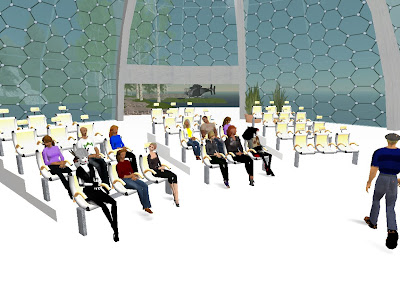 Building an environment in a metaverse and turning the learners loose to go “learn” without guidance, goals or objectives will not lead to effective learning. One mistake organizations make when first creating a virtual world for learning is failing to script the instruction. They create a space but have vague learning outcomes or even no plan for assessment.
Building an environment in a metaverse and turning the learners loose to go “learn” without guidance, goals or objectives will not lead to effective learning. One mistake organizations make when first creating a virtual world for learning is failing to script the instruction. They create a space but have vague learning outcomes or even no plan for assessment. When designing instruction in a virtual world, the basic tenants of instructional design still apply. Instructional designers need to develop measurable learning objectives, apply appropriate design strategies and create assessment items to measure whether or not the learners understand and can apply what they learned during their time in the virtual world.
This means you can’t just put people in a virtual space and say “explore” you need to tell them what to look for, what to do when they find a specific item and how that applies to what they should be learning. You can’t create a role play without giving the learners some guidance in terms of what they should say and how they should interact. You can’t have an event without a debriefing to ensure learners understand what happened and how it is related to their job. You need to create a method to evaluate their ability to apply what they learned in the virtual world to similar real world situations.
Scripting the learning event by specifically explaining to the learners their tasks and expectation through verbal commands or other learning aids like note cards or information embedded on in world billboards or signs is important. Thinking through the interaction between the learners, the instructor and the environment is what makes learning in a virtual world effective. A lack of preparedness will cause confusion on the part of the learners and they will quickly become frustrated with their experience.

One the other hand, do not script every single minute within the virtual world. Provide plenty of time for the learners to interact with each other and to share information. It may even be a good idea to require learners to work together to accomplish goals.
When scripting the instruction take advantage of the social networking capabilities and features of the virtual world to encourage the learners to interact and to build bonds in world just as you would in a physical classroom.
The time taken to build a social network in world will be returned to the organization when these learners interact and share information outside of the world and inside of the world to solve common issues they encounter on the job.
__
Recommended Games and Gadgets
Recommended Books
Content Guide











2 comments:
"One mistake organizations make when first creating a virtual world for learning is failing to script the instruction. They create a space but have vague learning outcomes or even no plan for assessment."
Interesting to hear; especially as this would seem close to common sense if enacted in the real world.
I've felt this same kind of disorganization in other parts of online worlds (my experience lies mostly with Second Life). Appears as though people are having a hard time realizing parallels of virtuality and reality, often leaving out important parts when it comes to organization.
Good post, informative.
Thanks, yes, it never ceases to amaze me that we keep making the same mistakes with every new learning technology.
Post a Comment